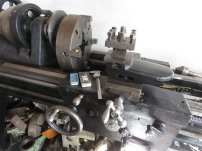So it seems the Regal is a somewhat medium duty lathe, my bad, didn't do some googling beforehand and just thought all Leblonds are brick outhouses of their kind.
Fun fact, it's actually as common to come across old DPRK (North korean) lathes over here as it is to find US stuff. Might be some odd result of (kinda forced) bilateral trade between USSR and Finland in the 1970/80's
Had a closer look to my old lathe today, i would call it medium duty at it's best but not feeble at all. Picture related, it's the actual unit i have. It's made by Karhula factory in the coastal-eastern Finland. There's a 6" mitutoyo caliper and some CNMG1606 inserts (big box and on the chuck jaw) for size comparison. The 4-jaw is 360mm (14"). The toolpost can take 50mm (2") toolholders.
I'm pretty certain it can push these kind of inserts to some reasonable material removal rates. I rarely have to run machines flat out, since usually the rigidness of the workholding or tool is the limiting factor in these short run jobs. There is this one job that comes to mind is when i made some vintage aircraft cylinders out of solid 160mm (6"+) 42crmo steel with the TOS lathe. I had to use a 80mm spade drill and rough few steps on the OD. I used CNMG1204 inserts and ran it around 220-350rpm and the chips came off blue and left a steaming hot pile in the chip tray.
Kinda went a bit offtopic with these vintage tools, let's crunch some numbers again and hope somebody does read these walls of monolog text!

Let's have for example the CNC shop i used to run in the city, with numbers updated to today's rates.
We shall assume a shop rate of 50€/hr (+materials +special tools)
-A rent of 800€/month and machine payments of 575€/month (enough for a 90's VMC and a turning center, cam package + support stuff)
-Electric/heating bill of 200€/month average.
And the numbers for current shop i have;
-Shop rate of 38€/hr (+materials +special tools)
-Payment for shop building, heating, electricity and machines: 0€ (everything paid for)
-Maintenance of engine, lineshafts, shop building and electrical components: 60€/month (when something breaks or needs parts, there is some money already dedicated to it)
And then the different scenarios, let's start with a very basic full time shop work, 120 billable hours per month;
CNC shop would have income of 6000€/month. If i subtract the overhead, there is 4425€ of profit, where i would have to deduct all the standard cutting tools, maintenance for the machines, insurances and mandatory retirement payment. It would end up around 3500€/month for salary before income tax.
This old school shop would have numbers of 4560€ income, 4500€ profit and salary of 3800€/month (less costs for cutting tools and no need for hired machine repair/electrical guy)
But this is where the fun begins! What happens if i work only 1/3 of the time (40 hours a month)? If there is an economic downturn with no work around or i'm exhausted about the full time work and wish to ease down a bit (thats what i'm currently doing)
The CNC shop would have numbers of 2000€ income, profit of 425€ and probably no salary for me after other costs.
This oldschool shop would have numbers of 1520€ income, 1460€ profit and salary of around 1200€ before taxes.
Then the worst case scenario, no work at all! (or a long holiday off the shop, wheeee

)
The CNC shop would have no income, profit of -1575€/month and my salary would end up at least this much negative. So i would have to put money back to the company to keep it alive.
This oldschool shop would have no income and no overhead, since the machines are not run, thus not consuming any fuel or electricity. There would be a chore of chopping firewood and keeping basic heat in the shop to prevent condensation on the tools and keep moisture out the building.
These numbers are the ones that excited me trying this out. I have scheduled the shop to start doing paying work around next winter, since i rather have it fully tooled up before accepting work, in order to actually do stuff instead of tooling. During the summertime i have to work in my veggie garden and build the timberframe house to live in. Winters are wet, dark and cold, so i rather spend them inside the warm workshop..





 )
)

